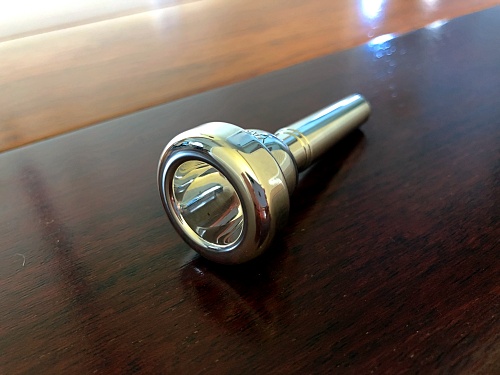Just starting out with the cornet?
If you or your child is just starting out you can often use a school’s instrument. That’s a goodness. The only thing that’s needed is a cornet mouthpiece. If that’s where you are, congratulations and welcome to the band ! If you’ve been playing for a while and looking for a new Cornet mouthpiece, skip to down to the Better Player ones.
So what is a mouthpiece and why is that the starting point? The mouthpiece is what you put on your face to make music. The lips will buzz when air is blown through them. The cornet mouthpiece supports the lips and creates the sound. If you are curious, please see our trumpet Mouthpiece Guide for an in-depth explanation of mouthpieces, what the numbers and letters mean. The lips, supported by the surrounding muscles in the face, form an embouchure (ahm-beh-shur). The embouchure describes how we hold their lips together while keeping an opening for the air to pass through. The mouthpiece and Cornet transform this vibration of the lips into beautiful notes. Wanna learn more about how this works? Here’s a great explanation.
Affiliate disclosure: As an Amazon Associate we earn qualifying purchases. This is to help support this site. This means if you click on links on reviewed products, we may earn a small commission on your purchase from Amazon. Please note that your price does not increase because of this. Thank you in advance for supporting the band.
Best Cornet Mouthpiece
Best Cornet Mouthpiece: 7C – Younger or smaller, beginning player
Blessing 7C
A 7C Cornet mouthpiece is the standard mouthpiece size for a younger or smaller, beginning player. Someone in elementary school for example that is just starting out. The “7” is the number which describes the cup diameter or how big the opening is. The “C” describes the cup itself. The gold standard is made by the Vincent Bach Company and their “Bach 7C” is arguably the most widely used mouthpiece for Trumpet and Cornet. It’s also a bit pricey, being north of $50.00. We like the Blessing 7C (model MPC7CCR). It is silver-plated brass, has a 16.20 millimeter cup diameter (which is considered medium to medium small) and a medium cup size. The 16.20 millimeter cup diameter is the same as the Bach mouthpiece. This is a great balance of smaller size to support their lips with a cup size that will deliver a bright, solid tone.
The Blessing mouthpieces have a slightly broader rim width (or will feel like that) because the outer rim shape isn’t as rounded as the Bachs are in general. This will help distribute the pressure of the mouthpiece across your lips more. This often feels better to those with straighter and/or flatter teeth.

Vincent Bach 7C
If the original Vincent Bach 7C is called for, you can’t go wrong. There are few (if any) Cornet or Trumpet players in the world who hasn’t had one of these exact mouthpieces. The more rounded inner and outer rim shapes make it feel very comfortable for most players. The more rounded rim shape is often more comfortable to those that may not have perfectly flat, aligned teeth.

Best Cornet Mouthpiece: 3C – Older, beginning player.
Blessing 3C
This mouthpiece would work for the middle school, or older beginning player. In fact, many players found their way to the the 3C and continue to play it for decades. It’s a standard that you can find in orchestras and jazz players alike. Someone who may have fuller lips may also like the extra room. This is a 3C Cornet mouthpiece. The “3” means the cup diameter is bigger than the “7” above at 16.30 millimeters. The slightly larger diameter may help for those with teeth that aren’t perfectly in line. The “C” is a medium sized cup for all around playing and development. The Blessing 3C would work well as above with it’s less rounded outer rim that will feel like the pressure is distributed across a larger area.

Vincent Bach 3C
If the original Vincent Bach version, 3C Cornet mouthpiece is desired, that is also a very popular mouthpiece. Same reasons as the 7C above when compared to the Blessing. It’s more rounded rim contours are very comfortable and enjoyed by many. One of the long time players in the band plays the Bach 3C. Has for several decades for orchestra and jazz. And yes, he can play high on it too. It’s a very versatile mouthpiece that many horn players love.

Best Cornet Mouthpiece: 4B – Better player.
Denis Wick 4B
This mouthpiece would assume the player has done well with their current mouthpiece and is playing more challenging music passages. Or their teacher sees that their current mouthpiece is holding them back somehow. More complex music compositions are filled with low to high notes with quick changes and crisp articulation. Before making a change, please understand that it takes time to adapt to a new one. These mouthpieces also assume the player has played for some time, taken lessons, and developed their embouchure. They are able to play soft, loud, and high on their current mouthpiece.
Note that naming convention is opposite of the Bach and Blessing. The smallest cup diameter in the Bach and Blessing line is “1”. For Denis Wick, the smallest is “5” and the largest is “1”. Our top pick for a more advanced player is the Denis Wick 4B Cornet mouthpiece. It has a medium cup, a 16.40 millimeter cup diameter, and a v-type backbore. What is that? That is the shape of the tubing of the mouthpiece as it enters the cornet. The V-type backbore helps produce a more focused, responsive sound. The Denis Wick 4B has one of the tighter bores in their cornet line at 4.3 millimeters. This help with the upper register with a bit of supportive backpressure. This mouthpiece encourages better playing habits as it plays best with lighter lip pressure. This is because Denis Wick mouthpieces presents a broader rim as the outer rim contour is less rounded. See our review below of the Denis Wick 4E lead trumpet mouthpiece (it has their shallowest cup).

Denis Wick 2B
If your child is more developed physically, or finds their 7C or 3C too small, the Denis Wick 2B Cornet mouthpiece may be the ticket. It has a 17.00 millimeter cup diameter, medium cup with a V-type backbore. Very similar as the 4B above, the 2B has a 4.3 bore which helps support the upper register.

Thanks for playing along !


